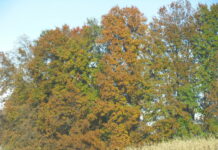Photo credit: DiasporaEngager (www.DiasporaEngager.com).
Kailey Lewis, MPH1; Michael Vasser, MPH2,3; Katie Garman, MPH1; Jeffrey Higa, MPH4; Michael Needham, MPH4; D. J. Irving, MPH1; Steffany Cavallo, MPH1; Dominique Sullivan; Marks, MPH5; Margaret Kirchner, PhD6; Asma Madad, MS, MPH6; Zachary D. McCormic, MPH2; John Dunn, DVM, PhD1 (View author affiliations)
View suggested citation
On March 30, 2021, during weekly analysis of sequenced isolates, the Tennessee Department of Health identified two Salmonella Duisburg isolates that had been determined to be closely related by whole genome sequencing (WGS). The specimens containing the isolates were from two patients who reported eating the same brand of cashew brie (a vegan brie cheese alternative) at the same restaurant. A search of the National Center for Biotechnology Information (NCBI) Pathogen Detection Isolates Browser identified three additional Salmonella isolates, two from patients in California and one in Florida, that were closely related genetically to the Tennessee isolates. The California Department of Public Health confirmed that one patient consumed the same brand of cashew brie before becoming ill. The Florida Department of Health reported the patient followed a vegan diet, which excluded some potential food exposures. A multistate investigation to characterize illnesses and identify the outbreak source was initiated. Open-source access to WGS data through NCBI facilitated rapid investigation of this outbreak before it was large enough to be identified through standard multistate outbreak detection methods (1). Rapid detection, investigation, and product recall prevented additional illnesses.
A case was defined as a Salmonella infection with one of four outbreak strains (identified using WGS) with illness onset during December 1, 2020–May 9, 2021 (Figure). State and local officials interviewed patients about the foods they consumed before illness onset, including cashew brie, and where the foods were purchased. Product and environmental sampling were conducted at retail locations or at the sole cashew brie production facility identified during of the Food and Drug Administration (FDA) traceback investigation. Outbreak strains of S. Chester, S. Typhimurium, and S. Urbana were included in the investigation because patients reported consuming cashew brie and cashew brie and component ingredients tested positive for these strains of Salmonella. This activity was reviewed by CDC and was conducted consistent with applicable federal law and CDC policy.*
Overall, 20 cases were identified in four states: California (seven S. Typhimurium, three S. Chester, three S. Urbana, two S. Duisburg), Florida (one S. Chester, one S. Duisburg), Maryland (one S. Urbana), and Tennessee (two S. Duisburg). The median patient age was 26 years (range = 1–72 years); 65% were female. Five patients were hospitalized, and none died.
Among 19 patients who were interviewed, 15 reported eating the same brand of cashew brie during the week before illness onset. Thirty-six samples were collected by state and federal officials from component ingredients, in-process and finished products, and environmental swabs from the cashew brie production facility. Twenty-three (64%) samples yielded 51 Salmonella isolates, including 19 (95%) of 20 retail samples and four (25%) of 16 samples collected from the production facility. On the basis of these findings, the cashew brie producer voluntarily recalled all products. Four Salmonella strains were isolated from 51 food and environmental samples; the results of WGS analysis indicated that only S. Chester and S. Urbana detected in non-clinical samples were associated with human illness. In addition, S. Duisburg and S. Typhimurium were only isolated from clinical samples and not found in food or environmental samples.
On the basis of the food sample results and FDA traceback, the cashew ingredients used to make the brie products were the likely source of contamination. Review of cashew brie production revealed no lethality treatment (e.g., pasteurizing or irradiation) (2) before cashew processing. FDA worked with the cashew supplier to ensure potentially contaminated cashews were no longer on the market and the supplier implemented corrective actions.
Outbreaks associated with raw nut and seed products are well documented (3), and Salmonella outbreaks associated with cashew cheese have been reported (4). The lack of a lethality treatment for component ingredients can increase the risk of contamination in products that are served ready-to-eat and perceived as safe by the public. The identification of two persons who became ill after eating the same uncommon food at the same restaurant, paired with detection of a rare S. Duisburg serotype, led to an early hypothesis about the source of this outbreak. Open-source access to WGS data through NCBI enabled rapid investigation of this outbreak before it was large enough to be identified using the standard multistate outbreak detection methods (1). Rapid detection, investigation, and product recall prevented additional illnesses, given the detection of Salmonella in 95% of cashew brie products collected at retail locations during this investigation.
Acknowledgments
Outbreak investigation team members in jurisdictions affected by the outbreak; local and state partners in California, Florida, Maryland, and Tennessee; partners at Food and Drug Administration and CDC. Molly Leeper, PulseNet team, CDC; Ellen Gee, Human and Animal Food West Division 5, Food and Drug Administration; Parvin Arjmandi, Carol King, Maya Spann, Division of Laboratory Services, Tennessee Department of Health.
1Tennessee Department of Health; 2Division of Foodborne, Waterborne, and Environmental Diseases, National Center for Emerging and Zoonotic Infectious Diseases, CDC; 3Oak Ridge Institute for Science and Education, Oak Ridge, Tennessee; 4California Department of Public Health; 5Los Angeles County Department of Public Health, El Monte, California; 6Coordinated Outbreak Response and Evaluation Network, Food and Drug Administration, College Park, Maryland.
MMWR and Morbidity and Mortality Weekly Report are service marks of the U.S. Department of Health and Human Services.
Use of trade names and commercial sources is for identification only and does not imply endorsement by the U.S. Department of
Health and Human Services.
References to non-CDC sites on the Internet are
provided as a service to MMWR readers and do not constitute or imply
endorsement of these organizations or their programs by CDC or the U.S.
Department of Health and Human Services. CDC is not responsible for the content
of pages found at these sites. URL addresses listed in MMWR were current as of
the date of publication.
All HTML versions of MMWR articles are generated from final proofs through an automated process.
This conversion might result in character translation or format errors in the HTML version.
Users are referred to the electronic PDF version (https://www.cdc.gov/mmwr)
and/or the original MMWR paper copy for printable versions of official text, figures, and tables.
Questions or messages regarding errors in formatting should be addressed to
mmwrq@cdc.gov.
Source of original article: Centers for Disease Control and Prevention (CDC) / Morbidity and Mortality Weekly Report (MMWR) (tools.cdc.gov).
The content of this article does not necessarily reflect the views or opinion of Global Diaspora News (www.GlobalDiasporaNews.com).
To submit your press release: (https://www.GlobalDiasporaNews.com/pr).
To advertise on Global Diaspora News: (www.GlobalDiasporaNews.com/ads).
Sign up to Global Diaspora News newsletter (https://www.GlobalDiasporaNews.com/newsletter/) to start receiving updates and opportunities directly in your email inbox for free.
































